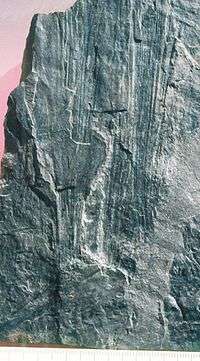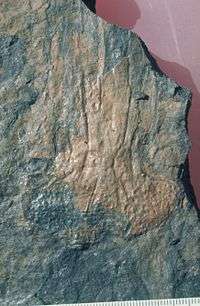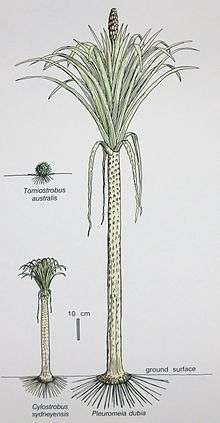Cylostrobus
| Cylostrobus Temporal range: Early Triassic | |
|---|---|
 | |
| Cones of Cylostrobus sydneyensis from the Early Triassic Newport Formation near Narrabeen, NSW, Australia.[1] | |
| Scientific classification | |
| Kingdom: | Plantae |
| Division: | Lycopodiophyta |
| Class: | Isoetopsida |
| Order: | Isoetales |
| Family: | †Pleuromeiaceae |
| Genus: | Cyclostrobus Retallack 1995 |
| Species | |
| |

Leafy apex of Cylostrobus sydneyensis from the Early Triassic Newport Formation near Avalon, NSW

Corm of Cylostrobus sydneyensis from the Early Triassic Newport Formation near Avalon, NSW

Reconstructions of extinct lycopsids Pleuromeia dubia and Cylostrobus sydneyensis (Pleuromeiaceae and Tomiostrobus australis (Isoetaceae) all from the Early Triassic Gosford and Newport Formations of the Sydney Basin, NSW, Australia.
Cylostrobus is genus of Lycopsida most like Pleuromeia, but with very compact and round cones. It is known from the Early Triassic of Australia, coincident with a marked greenhouse spike at the end of the Early Triassic.[2] The genus Cylostrobus was erected for the compact cone only, in the paleobotanical system of form genera, but these small plants are well enough understood that the name Cylostrobus sydneyensis is used for the whole plant, rather than the old name Pleuromeia longicaulis. Other species of Pleuromeia have attached cones that are less compact and produce different spores.
See also
References
- ↑ Retallack, Gregory J. (1997). "Earliest Triassic origin of Isoetes and quillwort evolutionary radiation". Journal of Paleontology. 7 (3): 500–521.
- ↑ Retallack, Gregory J. (2013). "Permian and Triassic greenhouse crises". Gondwana Research. 24: 90–103. doi:10.1016/j.gr.2012.03.003.
This article is issued from Wikipedia - version of the 8/5/2016. The text is available under the Creative Commons Attribution/Share Alike but additional terms may apply for the media files.